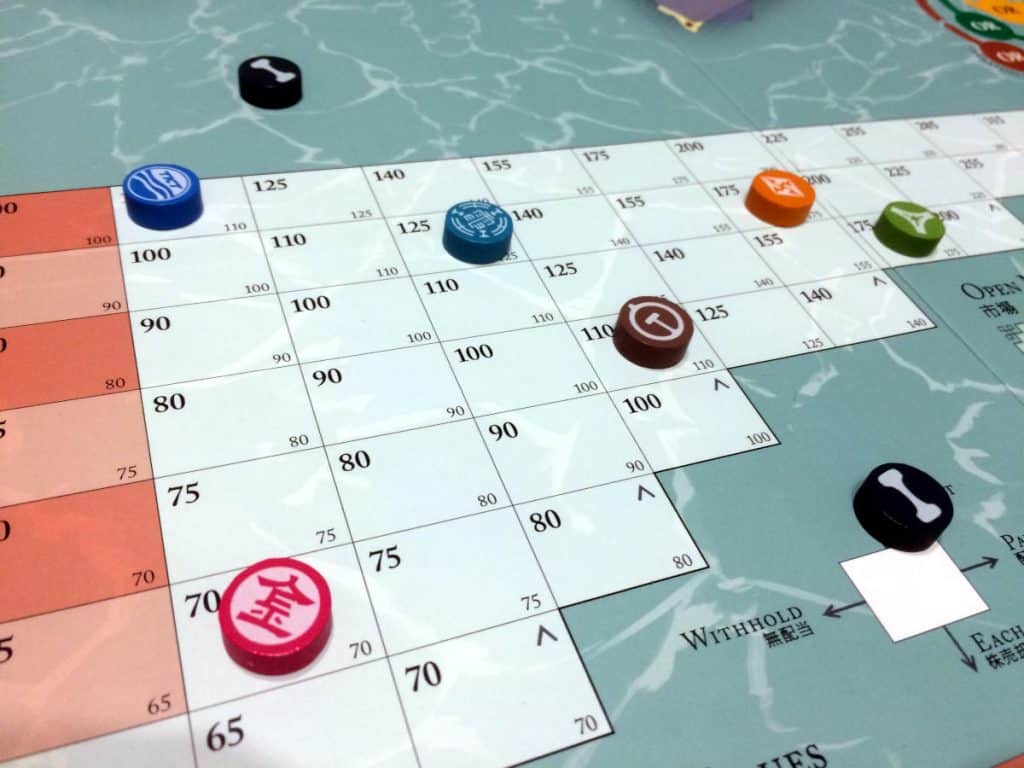If you know me, you’ll know that I love economic simulation games. I love trading stocks and shares. It feels great when I buy into someone else’s company and ride their success to profit. It feels even better when my own company does well and I can take all the gains for myself, because nobody else believed it would do so well. Add to that my love for playing with toy trains and you can see why I’m in love with 18xx games. So allow me, if you will, to take you on a journey of trains, tracks, stations and shares.
Listen to the Audio Version
Intro Music: Bomber (Sting) by Riot (https://www.
Tivinize by Sascha Ende
Free download: https://filmmusic.
License (CC BY 4.0): https://filmmusic.
Economic Simulations
I’ve previously written about my fascination for economic simulation games. I described how these games activate my brain’s reward centres and how I love the bluffing that often is a core part of allowing you to get the most profit and win. It’s so enjoyable how you can seemingly make money out of nothing. I adore how you need to try and keep players on your side just long enough, so that you can make the most profit, before royally screwing them over and leaving them behind. At the same time, you are at risk of being outsmarted yourself by your fellow players.
The mix of forming temporary alliances, trying to second-guess what everyone else is planning and being able to get financial gains from doing well is really exciting for me. These are the same reasons why I love Dune, where scheming and plans within plans are what makes the game tick. It explains why Oath and Pax Pamir 2e have such a great appeal for me.
In the games I mentioned so far it’s the players who create the tension and excitement. They decide whether to do their own thing or work together and when. However, in 18xx the games themselves have an in-built dynamism that players have to deal with, whether they want to or not.
18xx Games
There is a lot that players control and decide when to do. What shares they buy and when is their choice. Players can decide to invest in others’ corporations or try and become the president of their own. Laying track and placing stations are also optional.

Get yourself a wooden Tabletop Games Blog dice tray.
Each tray is the perfect size to roll your dice, and with the soft mat, it’s really quiet, while the wooden frame makes it wonderfully sturdy.
However, once one train line is connected to two stops, it is forced to buy a train. Suddenly, stock prices start to change. First they go down, but each operating round when income is paid out to shareholders, the price goes up. As more tracks are laid and more stations placed, the train company is strongly encouraged to buy more trains, so more income can be generated.
At first, there is no desperate need to follow what other players are doing. A train company can happily run with a single train. However, it won’t make much money. In turn, players who own shares in the company won’t make much money either. That’s fine, if that income is still higher than other players’. Yet, chances are someone else is making more, so it’s time to get another train to catch up.
The engine of the game is slowly starting to kick in. The game is in motion and while the pace is still quite leisurely, players start to feel more pressure to keep up.
That’s when 18xx games add coal to the fire and increase the pressure. As more trains are bought by corporations, older trains start to rust. Suddenly, an established company can end up without any trains. Somehow they have to find money to buy a new train and sometimes it’s the owning player who has to contribute from their own cash.
It’s that built-in dynamism that I think makes 18xx games so exciting.

18xx Variations
Yet, the genre isn’t a one-track pony. While you might want to start your foray into 18xx with a game such as Shikoku 1889, once you understand the basic principles, you have access to a whole world of games that function the same at the core, but have enough differences and tweaks that create completely different gameplay experiences.
Not only can you choose from a huge variety of maps, offering something for pretty much anyone, but each map is basically a variation of the basic 18xx rule set. For example, in 1880: China you have different types of trains and there is a phase when the stock market is frozen. In 18Chesapeake, each round a train is removed from the pool, speeding up when new trains become available and old ones rust. If you want a tiny map, try 18MS.
For a genre that was sparked by Francis Tresham‘s 1829, it is amazing how much variety there is available. In fact, my mind boggles when I look at how many 18xx games are available. I really think there is the perfect map for everyone and for every player count. The possibilities are almost endless. Just look at the list of 18xx games you can play free online at 18xx.games.
I know the genre can seem a bit daunting, but it really isn’t too hard to get into. I recommend you start with Shikoku 1889 and watch Ambie Valdes‘ great video to help you learn how to play. You probably won’t finish it the first time around, but that’s all right. Once you get the hang of it, try 18Chesapeake which is surprisingly quick to play. We’ve been able to play it on 18xx.games in about two and a half hours, but we didn’t rush it.
How About You?
Now I wonder what you think about the genre of 18xx games. Have you tried any of them yet? Are you put off by their perceived complexity? Or are you just not a fan of economic simulation games? If you have tried an 18xx game, what was it? Do you have a favourite? As always, please share your thoughts and experiences in the comments below. I’d love to hear from you.
For behind-the-scenes updates, branded merchandise, and more, please support the blog.
Useful Links
- Buy, Buy, Buy – my love affair with economic simulation board games: https://tabletopgamesblog.
com/ 2024/ 02/ 06/ buy-buy-buy-my-love-affair-with-economic-simulation-board-games-topic-discussion/ - Dune review: https://tabletopgamesblog.
com/ 2020/ 02/ 08/ dune-saturday-review/ - Oath: Chronicles of Empire and Exile review: https://tabletopgamesblog.
com/ 2021/ 11/ 27/ oath-chronicles-of-empire-and-exile-saturday-review/ - Pax Pamir Second Edition review: https://tabletopgamesblog.
com/ 2022/ 08/ 27/ pax-pamir-second-edition-saturday-review/ - 18xx games: https://tabletopgamesblog.
com/ tag/ 18xx-games/ - Shikoku 1889 review: https://tabletopgamesblog.
com/ 2024/ 07/ 06/ shikoku-1889-saturday-review/ - 18xx.games: https://18xx.
games/
Videos
Audio Version
Intro Music: Bomber (Sting) by Riot (https://www.
Tivinize by Sascha Ende
Free download: https://filmmusic.
License (CC BY 4.0): https://filmmusic.
Playlist
These are the songs I listened to while I was writing this topic discussion article:





